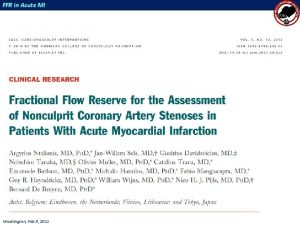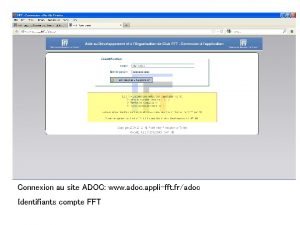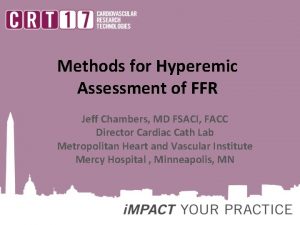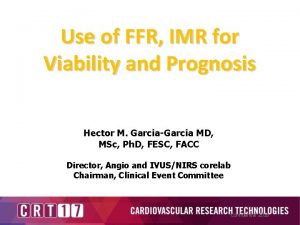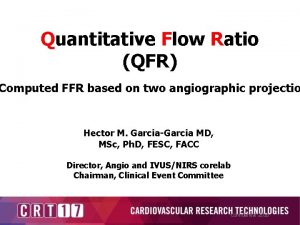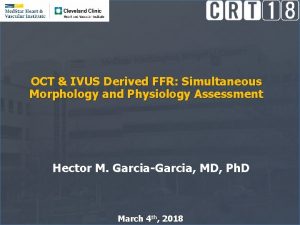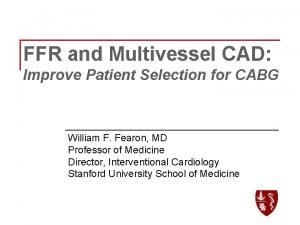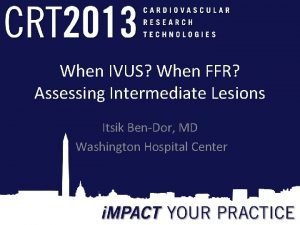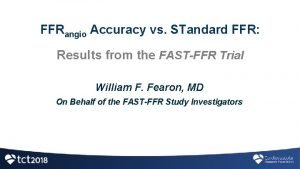i FR versus FFR What are the Differences
































- Slides: 32

i. FR versus FFR: What are the Differences? CRT 2013 Monday, February 24 th, 2013 Habib Samady MD FACC FSCAI Professor of Medicine Director, Interventional Cardiology and Cardiac Catheterization Laboratory, Emory University Hospital, Atlanta, GA

Habib Samady, MD Research Grant: St. Jude Medical Volcano Corporation American Heart Association National Institute of Health - Co-I R 01 HL 085417 - Co-I PPG RO 1 Off-Label Discussion: IFR

“i. FR versus FFR: What are the Differences? ” • FFR is Gold Standard for Intermediate Lesion Assessment • Rationale and Basis for i. FR • Comparative Studies • Hybrid Strategy • Conclusions

“i. FR versus FFR: What are the Differences? ” • FFR is Gold Standard for Intermediate Lesion Assessment • Rationale and Basis for i. FR • Comparative Studies • Hybrid Strategy • Conclusions

FAME FFR-Guided Angio-Guided 720 days 4. 5% Fearon. JACC. 2010 Fearon. Circulation. 2010; 122: 2545 -2550

ACC/AHA PCI Guidelines: FFR I IIa. IIb. III It is reasonable to use intracoronary physiologic measurements (coronary pressure [FFR])(Level of Evidence: A) in the assessment of the effects of intermediate coronary stenoses (30% to 70% luminal narrowing) in patients with anginal symptoms. NCDR PCI Registry Quality Indicator: FFR

“i. FR versus FFR: What are the Differences? ” • FFR is Gold Standard for Intermediate Lesion Assessment • Rationale and Basis for i. FR • Comparative Studies • Hybrid Strategy • Conclusions

What Diameter Stenosis Requires Physiologic Interrogation? Tonino. JACC 2010; 55(25): 2816 -21

FFR Use in the United States • 6. 9% of patients with moderate undergoing PCI had FFR • 1. 2% of patients of all patients undergoing PCI had FFR Datillo et al. TCT 2011 AHA 2012

Impediments to Greater FFR Use • Occulo-stenotic reflex • Patient expectations • Physician expectations and incentives • Practical issues - Adenosine Issues - IV vs. IC - dosage - side effects - cost - time

Fractional Flow Reserve: Theory Flow = Pressure Gradient / Resistance PAo 100 mm. Hg Pd 70 mm. Hg Pv 0 mm. Hg P= 30 mm. Hg myoc. perfusion press. = 70 mm Hg Pijls et al. , Circ. 1995; 92: 3183 -3193 FFR = Pd-Pv/R PAo-Pv/R FFR = 70/100 FFR = 0. 70

i. FR = instantaneous wave-free ratio 25% 5 ms Definition: Instantaneous pressure ratio, across a stenosis during the wave-free period, when resistance is naturally constant and minimised in the cardiac cycle Sen S et al. J Am Coll Cardiol. 2012 Apr 10; 59(15): 1392 -402 Wave-free period Pa Pd

Velocity, Pressure and Resistance FFR vs i. FR FFR i. FR HIGHER FLOW BIGGER GRADIENT LOW AND STABLE RESISTANCE Sen et al. JACC Jan 2013 epress

“i. FR versus FFR: What are the Differences? ” • FFR is Gold Standard for Intermediate Lesion Assessment • Rationale and Basis for i. FR • Comparative Studies • Hybrid Strategy • Conclusions

ADVISE N=157 patients with intermediate and severe stenoses Sen S. et al. JACC 2012

Early Comparative Studies on i. FR vs FFR Study n Blind Population Receiver operator curves Classification accounting for FFR distribution ADVISE 1 157 No Intermediate and severe 93% 88/93=94% ADVISE Registry 2 339 No Intermediate 86% 80/85=94% South Korean 3 238 Yes Intermediate 89% 81/86=94% FORECAST 5 71 No ACS 94% 1. 2. 3. Sen S et al. J Am Coll Cardiol. 2012 Apr 10; 59(15): 1392 -402 Petraco R et al. Eurointervention. 2012 August ( e-pub online) Park et al. (Euro. PCR 2012, under review). 4. De Rosa et al. TCT 2012, Abstract session

VERIFY N=206 patients referred for PCI Diagnostic Accuracy 60% Berry. et al. epub JACC 2013 Diagnostic Accuracy 51% In the FFR 0. 6 -0. 9 range

VERIFY, ADVISE, and RESOLVE ADVISERegistry VERIFY Number 1539 330 206 Classification agreement i. FR with FFR 80% 50 -60% Receiver operator curve 88% 86% 89% Jeremias A, Stone G et al. TCT 2012 Petraco R et al. ADVISE-Registry Eurointervention August (Epub online) Berry C et al. VERIFY. JACC February (Epub online)

Resistance: FFR vs i. FR FFR i. FR HIGHER FLOW BIGGER GRADIENT LOW AND STABLE RESISTANCE Sen et al. epub JACC 2013

Diastolic vs. Mean Hyperemic Myocardial Resistance N=120 pressure/velocity recordings Johnson. et al. epub JACC 2013

Myocardial Resistance during i. FR and FFR: Insights from CLARIFY Resistance lowered with adenosine Resistance lower at rest Sen et al. epub JACC 2013 NON SIGNIFICANT STENOSIS HSR>0. 8 mm. Hg. cm/s SIGNIFICANT STENOSIS HSR<0. 8 mm. Hg. cm/s

CLARIFY i. FR, i. FRa, and FFR vs. HSR n=51 ROC Area Under Curve i. FR 0. 93 i. FRa 0. 94 FFR 0. 96 Sen et al. epub JACC 2013 p=0. 48

“i. FR versus FFR: What are the Differences? ” • FFR is Gold Standard for Intermediate Lesion Assessment • Rationale and Basis for i. FR • Comparative Studies • Hybrid Strategy • Conclusions

RESOLVE Primary endpoint : i. FR reduces adenosine requirement by 57% n=1539 57% reduction Patients requiring adenosine 100 80 60 40 • 94% overall classification agreement with FFR • 57% patients spared from adenosine using i. FR • 33% more patients are spared from adenosine than resting Pd/Pa alone. 20 0 FFR i. FR Jeremias A, Stone G et al. RESOLVE, TCT 2012

Match with FFR HYBRID IFR-FFR A D E N O i. FR ONLY S I DEFER safe N PCI indicated 80% E 0. 4 0. 5 0. 6 0. 7 0. 8 0. 9 1. 0 i. FR values Petraco R et al. Eurointervention. 2013 December (e-pub online) Z O N % more than Pd. Pa

HYBRID IFR-FFR A Match with FFR % more than Pd. Pa 95% 33% D E <0. 86 N >0. 93 O i. FR ONLY S I DEFER safe N PCI indicated 80% E 0. 4 0. 5 0. 6 0. 7 0. 8 0. 9 1. 0 i. FR values Petraco R et al. Eurointervention. 2013 December (e-pub online) Z O N

HYBRID IFR-FFR A <0. 84 D E <0. 86 >0. 95 N >0. 93 Match with FFR % more than Pd. Pa 97% 40% 95% 33% O i. FR ONLY S I DEFER safe N PCI indicated 80% E 0. 4 0. 5 0. 6 0. 7 0. 8 0. 9 1. 0 i. FR values Petraco R et al. Eurointervention. 2013 December (e-pub online) Z O N

HYBRID IFR-FFR <0. 82 A <0. 84 >0. 96 D E <0. 86 >0. 95 N >0. 93 Match with FFR % more than Pd. Pa 99% 72% 97% 40% 95% 33% O i. FR ONLY S I DEFER safe N PCI indicated 80% E 0. 4 0. 5 0. 6 0. 7 0. 8 0. 9 1. 0 i. FR values Petraco R et al. Eurointervention. 2013 December (e-pub online) Z O N

“i. FR versus FFR: What are the Differences? ” • FFR is Gold Standard for Intermediate Lesion Assessment • Rationale and Basis for i. FR • Comparative Studies • Hybrid Strategy • Conclusions

• Diagnostic Accuracy of i. FR vs FFR 80% (60 -90%) • Diagnostic Accuracy of i. FR comparable to FFR using HSR as gold standard • Hybrid Strategy ? Better or more complex • Given substantial body of outcome data supporting its use, FFR remains the gold standard • Whether i. FR based or hybrid based outcomes Studies are warranted is under debate Samady et al. epub JACC 2013

i. FR versus FFR: What are the Differences? CRT 2013 Monday, February 24 th, 2013 Habib Samady MD FACC FSCAI Professor of Medicine Director, Interventional Cardiology and Cardiac Catheterization Laboratory, Emory University Hospital, Atlanta, GA

N=206 patients referred for PCI Berry. et al. JACC 2013
 Mikael ferm
Mikael ferm Tera ffr
Tera ffr Comet ffr wire
Comet ffr wire Ffr dijagnostika man
Ffr dijagnostika man Adoc ffr
Adoc ffr Ffr
Ffr Jeff chambers md
Jeff chambers md Disadvantages of ffr
Disadvantages of ffr Ivus ffr
Ivus ffr Https oval e ffr fr
Https oval e ffr fr Ffr i
Ffr i Recruter et fidéliser bénévoles ffr
Recruter et fidéliser bénévoles ffr Môn thể thao bắt đầu bằng chữ đua
Môn thể thao bắt đầu bằng chữ đua Khi nào hổ mẹ dạy hổ con săn mồi
Khi nào hổ mẹ dạy hổ con săn mồi điện thế nghỉ
điện thế nghỉ Biện pháp chống mỏi cơ
Biện pháp chống mỏi cơ Trời xanh đây là của chúng ta thể thơ
Trời xanh đây là của chúng ta thể thơ Voi kéo gỗ như thế nào
Voi kéo gỗ như thế nào Thiếu nhi thế giới liên hoan
Thiếu nhi thế giới liên hoan Số nguyên tố là gì
Số nguyên tố là gì Fecboak
Fecboak Các châu lục và đại dương trên thế giới
Các châu lục và đại dương trên thế giới Một số thể thơ truyền thống
Một số thể thơ truyền thống Thế nào là hệ số cao nhất
Thế nào là hệ số cao nhất Hệ hô hấp
Hệ hô hấp Tư thế ngồi viết
Tư thế ngồi viết Hát kết hợp bộ gõ cơ thể
Hát kết hợp bộ gõ cơ thể đặc điểm cơ thể của người tối cổ
đặc điểm cơ thể của người tối cổ Mật thư anh em như thể tay chân
Mật thư anh em như thể tay chân Tư thế worm breton
Tư thế worm breton ưu thế lai là gì
ưu thế lai là gì Thẻ vin
Thẻ vin Bàn tay mà dây bẩn
Bàn tay mà dây bẩn



